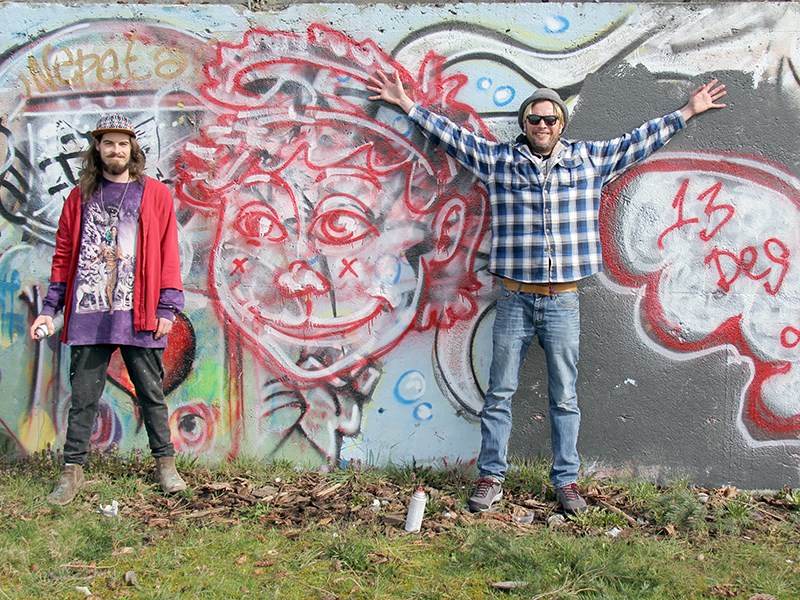A 2011 City of Powell River bylaw regulating unsightly premises in Powell River prohibits graffiti. That law defines graffiti as “drawing, printing or writing scratched, sprayed, painted or scribbled on a wall, fence, or other surface that is visible from a highway, sidewalk, park or other public place.”
A person convicted of a graffiti crime can be liable to a fine of $1,000 to $10,000, according to the bylaw.
“To my knowledge, it is not really enforced,” said Powell River city councillor CaroleAnn Leishman. “[Police] have to catch the culprits red-handed, I believe, in order to be able to take any action.”
The act of graffiti on public or private space is variously described as vandalism, mischief, defacement, anti-social behaviour and art. Which begs the question, is graffiti art or vandalism?
“Some graffiti can be quite artistic, but there should be specific places where it is acceptable,” said Leishman. “Tagging businesses and buildings is not cool as it costs business owners and other organizations to have to cover it over with fresh paint, and it certainly doesn’t look good on a building. Some concrete walls could potentially be designated in certain locations, but at this point there aren’t any officially acceptable locations, to my knowledge.”
The biggest unofficial public exhibit of graffiti in Powell River is known as “the wall.” It is the concrete retaining wall along the side of the gravel lot near the upper parking lot of Willingdon Beach.
According to artist Adam Cramb, the history of the wall goes back to when the roof of the civic arena at Willingdon was covered in the graffiti of graduating year classes. Then about six years ago, he said, the wall became a place of public expressions.
“It’s a place to practice, to show and to share,” said Cramb. “If anyone has the courage to use the wall, they’re free to use it. People can put up who they are and the next day someone can paint over it. It’s commonplace.”
Powell River RCMP constable Tim Kenning said the graffiti on the wall is totally different from recent tagging, such as an incident involving a thrift shop panel van.
“They’re not harming anybody down there. It seems to be an acceptable place to put tasteful art,” said Kenning.
Vandalism is a part of street-art graffiti that turned into something accepted, said Stefan Fogarty, also known as Catnip, a local graffiti artist and one of the members of Kaleidoscope art collective on Marine Avenue.
“It’s highly social in that it’s active and physical,” said Fogarty, “more antisocial would be to just sit at home and do nothing. It is subversive and it is against the societal norms.”
There is a distinction between graffiti and vandalism, according to internationally-recognized artist Luke Ramsey, now based in Powell River. Ramsey’s client list includes the New York Times, Drake Hotel, Mountain Equipment Co-op and Patagonia.
“Graffiti is an energy, a subjective expression of love, hate, humour, rebellion, art, freedom and tagging for territory and sport,” said Ramsey. “Vandalism is an idea, a perception of property, law and ownership. Someone walks into an art-supplies shop and paints on a blank canvas with a price tag on it. Does the shop owner yell ‘vandal’ and contact the law? Or, does the shop owner proclaim ‘art’ and try and sell the canvas or offer the artist an exhibition?”
Local authorities have noticed an increase in graffiti activity in the last few months. According to Kenning, locations such as the Town Centre Mall, behind the thrift shops, all around Townsite, up to Timberlane Park and the cadet barracks have been targets of graffiti tagging.
Removing graffiti can be costly. The price for paint needed to cover up recent tagging at the barracks was estimated at $1,000.
The act or art of tagging is urban slang for getting up, which means getting your name up on a wall. Despite there being a law against it, Kenning has no explanation for why there is more of it in recent months.
“We’ve had an influx of tagging all over the place,” said Kenning. “It’s very tasteless. It’s not art of any nature. It’s just mischief.”
According to Kenning, there have been no arrests made to date in connection with graffiti, despite a visible increase in tagging.
Cramb said he thinks if graffiti was removed on a regular basis, taggers will eventually give up.
“I see it as a tolerable delinquency,” he said. “When you look at the amount of graffiti that happens, considering the amount of space in Powell River, you have to actually look for it.”
Cramb said even the most rudimentary tagging could also be considered artistic expression.
“Those taggers are artists,” said Cramb. “They’re born artists.”
The only difference between taggers and graffiti artists, according to Cramb, is taggers start off unrecognized, while he and Fogarty have advanced from tagging into recognized artists.
“Graffiti and tagging are part of the same thing,” said Fogarty. “Taggers are growing with their style from these cheaply drawn tags.”
Fogarty thinks there is a way of channelling tagging into more productive acts, such as community mural projects where artists get together and aren’t frowned upon, but accepted.
“Powell River is going to see more of it, so how can we help change it into something that is more accepted, more social and without the label of vandalism?” asked Fogarty.
More than tagging for the sake of tagging, local painter Meghan Hildebrand views graffiti as an exciting and limitless art form.
Since 2001, Hildebrand has created artwork for the annual electronic music festival Shambhala, designing posters, tickets and merchandise. Her original works are shown at several galleries across Canada.
“The temporary nature of graffiti creates a vitality,” said Hildebrand, “and freshness to the art.”



